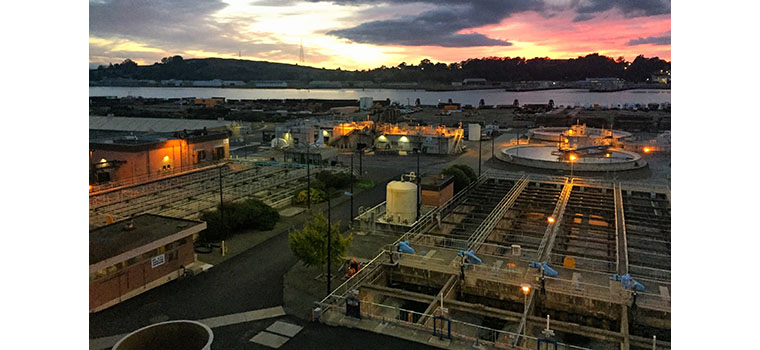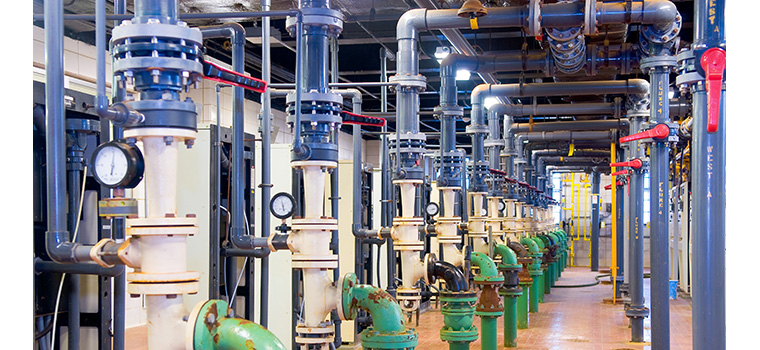California received $173.5 million last month from the United States Environment Protection Agency (EPA) to help fund improvements to the state's drinking water and wastewater infrastructures.

The city of Vallejo, which is responsible for providing drinking water to Mare Island, plans to replace an aging sewer pipe that runs across the Mare Island Strait this summer. Photo courtesy of Vallejo Flood & Wastewater District
BY BILL PICTURE
Published: March, 2018
California received $173.5 million last fall from the United States Environment Protection Agency (EPA) to help fund improvements to the state’s drinking water and wastewater infrastructures.
The money, which is supplemented with state funds, will be managed by the State Water Resources Control Board (SWRCB), whose Clean Water State Revolving Fund program and Drinking Water State Revolving Fund program award low-interest loans to communities for water projects.
“Investing in water infrastructure with our state partners is a priority and ensures communities can deliver safe drinking water and wastewater treatment,” said EPA Administrator Scott Pruitt in a written statement. “This funding is critical to supporting public health and environmental goals in California.”
“It’s the invisible stuff that every community relies on but no one really thinks about unless something goes wrong,” said EPA Region 9 Acting Regional Administrator Alexis Strauss.
Strauss commended communities throughout the state for doing a “pretty fabulous job” of maintaining their water infrastructures. “But even in a system that’s very well maintained, you’ll still find some of the old clay pipes that shift every time we have a small earthquake.”
It’s easier for large metro areas to keep their water infrastructures in tip-top shape, Strauss said. “They’re generally better-financed so their systems tend to be innovative, up to date and well run,” she said. Smaller and/or less solvent communities, on the other hand, he said have a rougher go of it. And it’s to such communities that the SWRCB makes an extra special effort to lend a hand.
“The State Revolving Fund programs allow us to help a wide variety of communities,” said SWRCB Vice Chair Steven Moore in a written statement. “But their financial strength and versatility are especially good at helping small and disadvantaged communities that might not have access to the capital they need.”
Strauss said one solution for small communities watching every penny is to band together and pool resources.“It’s really hard in this day and age for small drinking water systems, for instance —and California has thousands and thousands of them—to obtain, treat and provide safe drinking water,” she said. “But the state has some incentives to help them regionalize.”
The water line (item)
The cost to maintain drinking water and wastewater infrastructure varies greatly and depends on factors almost too numerous to mention. One big factor is the accessibility of the pipe, or more specifically, how difficult it is to access those pipes.
“For instance, repairs in the Oakland Hills area would be more expensive than repairing pipes in a flatter area because getting to the pipes is a lot more work,” Strauss said. Another thing delaying repairs and/or improvements in some communities is the question “Whose pipe is it anyway?”
A fair amount of sleuthing is often required to figure out who is responsible for the upkeep of any piece of the vast network of pipes under most communities. The pipes connecting a property to the street usually fall on the property owner’s plate. But from there, the pipes are a tangle of municipal and private utilities, and various regional and municipal agencies.
Recognizing that a game of hot potato keeps them from achieving the goal of a healthy water infrastructure that they all share, Strauss said stakeholders have begun to work more collaboratively. “They call it ‘integrated water management,’ which is basically looking at drinking water, storm water and wastewater in a much more holistic way,” he explained.
A good example is the effort to replace a well-past-its-prime piece of sewer pipe that crosses the Mare Island Strait in Vallejo. The pipe carries wastewater off the island; should it fail, this would threaten the health of the Napa River and adjoining San Pablo Bay. The EPA awarded a $1.2 million Special Appropriation Act Project grant to the Vallejo Flood and Wastewater District to replace the pipe.
When the district digs up the old pipe, the City of Vallejo, which is responsible for providing drinking water to Mare Island, plans to run new drinking water pipes through the bore. District spokesperson Jennifer Kaiser said pipes like the one being replaced typically last 25-30 years. This particular section of pipe turns 44 this year.
“For the last 10 years or so, we’ve done spot repairs on corroded seams as needed,” she said. “But it is now past the end of its useful life.” There are roughly 350 homes on Mare Island and another 2,500 people work there each day. The replacement project is expected to begin this summer.
What about the new budget?
EPA faces tough times if the 2019 budget that President Trump proposed last month clears the legislative hurdles before it. The President has made clear his feelings about the agency, even calling for it to be eliminated completely. Now he proposes a 23 percent budget cut that would eliminate dozens of programs.
That proposed budget includes Trump’s much anticipated infrastructure plan, which he first mentioned on the campaign trail. It’s anyone’s guess what parts of the infrastructure plan and budget will get tossed and which will survive (in one form or another); but the administration has said that safe drinking water and wastewater treatment are top priorities. Still, Strauss believes we can expect to see a continued focused on what she calls “shovel-ready projects.”
“Having been through the Obama-era infrastructure plan, I expect more of that same,” she said. “And by and large, these projects benefit larger communities. It’s much harder to make a visible difference in smaller and disadvantaged communities. We just have to wait and see what happens.”

Itís easier for large metro areas to keep their water infrastructures in shape since they are generally better-financed and their systems tend to be up to date. Photo courtesy of U.S. EPA

